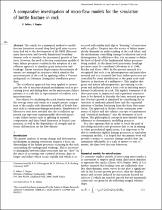 ResearchSpace
ResearchSpace
Comparative investigation of micro-flaw models for the simulation of brittle fracture in rock
JavaScript is disabled for your browser. Some features of this site may not work without it.
- ResearchSpace
- →
- Research Publications/Outputs
- →
- Journal Articles
- →
- View Item
| dc.contributor.author |
Sellers, E

|
en_US |
| dc.contributor.author |
Napier, J

|
en_US |
| dc.date.accessioned | 2007-02-06T08:53:49Z | en_US |
| dc.date.accessioned | 2007-06-07T10:03:14Z | |
| dc.date.available | 2007-02-06T08:53:49Z | en_US |
| dc.date.available | 2007-06-07T10:03:14Z | |
| dc.date.copyright | en_US | |
| dc.date.issued | 1997-07 | en_US |
| dc.identifier.citation | Sellers, E and Napier, J. 1997. A comparative investigation of micro-flaw models for the simulation of brittle fracture in rock. Computational Mechanics, vol 20, 02 January, pp 164-169 | en_US |
| dc.identifier.issn | 0178-7675 | en_US |
| dc.identifier.uri | http://hdl.handle.net/10204/1483 | en_US |
| dc.identifier.uri | http://hdl.handle.net/10204/1483 | |
| dc.description.abstract | The search for a numerical method to model fracture formation around deep level gold mine excavations had led to the development of the DIGS (Discontinuity Interaction and Growth Simulation) boundary element code to simulate the incremental growth of fractures. However, the need to develop constitutive models of basic failure processes resulted in the adoption of a tessellation approach to simulate grain interaction and breakage. Linear variation displacement discontinuity elements are arranged in structures which simulate the microstructure of the rock by applying either a Voronoi (polygonal) or Delaunay (triangular) tessellation procedure. The tessellation approach has been applied to investigate the role of micromechanical mechanisms such as pre-existing pores and sliding flaws on the macroscopic failure patterns at a scale that is representative of realistic rock microstructures. Procedures for calculating the crack density tensors and the average stress and strain in a sample permit comparison of the results with alternative models of brittle fracture such as continuum damage mechanics. Simulations of laboratory tests have revealed that the tessellation approach can represent experimentally observed macroscopic failure modes such as splitting in uniaxial compression and shear band formation in biaxial compression, as well as the dependence of strength and inelastic deformation on the flaw density. | en_US |
| dc.format.extent | 296554 bytes | en_US |
| dc.format.mimetype | application/pdf | en_US |
| dc.language.iso | en | en_US |
| dc.publisher | Springer-Verlag | en_US |
| dc.rights | Copyright: 1997 Springer-Verlag | en_US |
| dc.source | en_US | |
| dc.subject | Brittle rock fractures | en_US |
| dc.subject | Growth simulation | en_US |
| dc.subject | Micro - flaw models | en_US |
| dc.subject | Tessellation approaches | en_US |
| dc.subject | Micromechanical mechanisms | en_US |
| dc.subject | Sciences | en_US |
| dc.subject | Discontinuity interaction | en_US |
| dc.subject | Macroscopic failure patterns | en_US |
| dc.title | Comparative investigation of micro-flaw models for the simulation of brittle fracture in rock | en_US |
| dc.type | Article | en_US |
| dc.identifier.apacitation | Sellers, E., & Napier, J. (1997). Comparative investigation of micro-flaw models for the simulation of brittle fracture in rock. http://hdl.handle.net/10204/1483 | en_ZA |
| dc.identifier.chicagocitation | Sellers, E, and J Napier "Comparative investigation of micro-flaw models for the simulation of brittle fracture in rock." (1997) http://hdl.handle.net/10204/1483 | en_ZA |
| dc.identifier.vancouvercitation | Sellers E, Napier J. Comparative investigation of micro-flaw models for the simulation of brittle fracture in rock. 1997; http://hdl.handle.net/10204/1483. | en_ZA |
| dc.identifier.ris | TY - Article AU - Sellers, E AU - Napier, J AB - The search for a numerical method to model fracture formation around deep level gold mine excavations had led to the development of the DIGS (Discontinuity Interaction and Growth Simulation) boundary element code to simulate the incremental growth of fractures. However, the need to develop constitutive models of basic failure processes resulted in the adoption of a tessellation approach to simulate grain interaction and breakage. Linear variation displacement discontinuity elements are arranged in structures which simulate the microstructure of the rock by applying either a Voronoi (polygonal) or Delaunay (triangular) tessellation procedure. The tessellation approach has been applied to investigate the role of micromechanical mechanisms such as pre-existing pores and sliding flaws on the macroscopic failure patterns at a scale that is representative of realistic rock microstructures. Procedures for calculating the crack density tensors and the average stress and strain in a sample permit comparison of the results with alternative models of brittle fracture such as continuum damage mechanics. Simulations of laboratory tests have revealed that the tessellation approach can represent experimentally observed macroscopic failure modes such as splitting in uniaxial compression and shear band formation in biaxial compression, as well as the dependence of strength and inelastic deformation on the flaw density. DA - 1997-07 DB - ResearchSpace DP - CSIR KW - Brittle rock fractures KW - Growth simulation KW - Micro - flaw models KW - Tessellation approaches KW - Micromechanical mechanisms KW - Sciences KW - Discontinuity interaction KW - Macroscopic failure patterns LK - https://researchspace.csir.co.za PY - 1997 SM - 0178-7675 T1 - Comparative investigation of micro-flaw models for the simulation of brittle fracture in rock TI - Comparative investigation of micro-flaw models for the simulation of brittle fracture in rock UR - http://hdl.handle.net/10204/1483 ER - | en_ZA |





